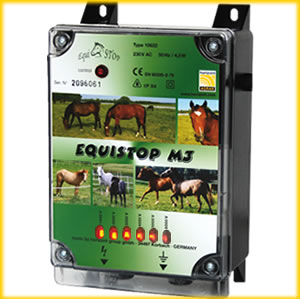You have no items in your shopping cart.
A Wimp of an Energiser will give you a wimpy fence. The Energiser needs to be powerful enough to deliver a definite jolt when your horse touches it, even when its current is reduced by vegetation touching the fence line or (as sometimes happens) by moist, dewy early-morning conditions. Ignore energisers whose power is rated by STORED joules - this figure does not mean much as it is simply  the energy stored in the capacitors before it goes through all the electronics to render it safe and effective. Depending on the quality of the electronics, there is always a loss in energy before it gets to the fence.
the energy stored in the capacitors before it goes through all the electronics to render it safe and effective. Depending on the quality of the electronics, there is always a loss in energy before it gets to the fence.
Look instead for one rated by OUTPUT joules, this a measure of the energy that the energiser is actually sending out to the fence once every second. One joule is a minimum rating for fencing that encloses up to five acres, it is recommend getting the most powerful energiser you can afford. A higher joule rating doesn't mean the fence's jolt--which can't injure horses or other animals--will be harder or more painful, but that it will be more consistent.
Some energisers are rated by "Miles of Wire". This is relative but remember these are invariably under test laboratory conditions and use the best conductors to achieve the maximum reading (better for marketing). Many companies still use this standard in evaluating their energisers, a unit which is rated as a fifty mile unit only means that it can effectively power 50 miles of a weed free, properly insulated, single strand of 12 gauge solid strand wire that is 30 to 36 inches off the ground. It does not take into consideration the weed loading or the electromagnetic resistance that occurs in multiple wire fences. A 50 mile energiser will not necessarily power 10 miles of five wire high tensile fence. Although an energiser rated in "Miles of Fence" may be as good as a unit rated in joules, it is difficult to make a fair comparison using this method of rating. It is also vital to appreciate that the general fence WILL NOT operate to these specifications.
unit which is rated as a fifty mile unit only means that it can effectively power 50 miles of a weed free, properly insulated, single strand of 12 gauge solid strand wire that is 30 to 36 inches off the ground. It does not take into consideration the weed loading or the electromagnetic resistance that occurs in multiple wire fences. A 50 mile energiser will not necessarily power 10 miles of five wire high tensile fence. Although an energiser rated in "Miles of Fence" may be as good as a unit rated in joules, it is difficult to make a fair comparison using this method of rating. It is also vital to appreciate that the general fence WILL NOT operate to these specifications.
No fencing system containing barb wire should ever be electrified. An owner of such a fence would be considered liable if any animal or person were to be caught up in such a fence. In order to reduce the chances of injury or property damage,
The difference in cost will be insignificant compared to the value of your horses and your peace of mind; expect to pay £100 to £120 for a good one-joule energiser that plugs into an outlet in the barn or elsewhere; six-joule energisers now sell for less than £200, a small premium for peace of mind. (Worried about your electric bill? Electric Fence energisers use negligible amounts of power, whatever their rating.) It's possible to run High Voltage insulated cable up to 1/2 mile from an energiser to the fence without significant power loss. Install the energiser under cover where you can check it easily during each day's routine. Most chargers have a light that flashes with the electric pulse when they're plugged in and functioning.
Low Impedance vs. High Impedance: A high amperage electrical charge is what causes the greatest amount of damage when it flows through anything that completes a circuit. In the older conventional electric fence controllers, the pulse rate was very long, sometimes nearly half a second. If the flow of electricity is not controlled in these style of energisers, they are not only a potential source of barn and grass fires, they can also be lethal to any animal that would become caught in the wire. Manufacturers of long pulse rate energisers put in resistors which restricted the flow of current out of the energisers, thus the term "high impedance". These high impedance energisers keep the amount of amperage down to a safe level but also make them more prone to shorting out and are generally ineffective over longer distances.
Low impedance energisers, don't want to restrict the volume of electricity to the extent the older style energisers do. They depend on the extremely high energy discharge and short pulse rate to keep an electric fence from being easily shorted out. It is the millisecond pulse rate that provides the safety factor in "low impedance" energisers. The vast majority of modern energisers are of the Low Impedance version








← Older Post Newer Post →
0 comments